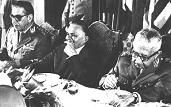Talvez, a outra possibilidade é que aqueles misseis, electrônicamente, estarem ao nivel de um AIM7 de ultima geração, que também não era uma coisa de "encher o olho"... Os R73 parece que funcionaram muito bem.
With the re-appearance of the EtAF fighters over the battlefield, it became clear to the Eritreans and their Ukrainian instructors, that they would have to fight down the newly-arrived Ethiopian Su-27s, or the ERAF would not be able to effectively support the war effort. Therefore, on the morning of 25 February four MiG-29s were sent to intercept two Su-27s which were patrolling along the front-lines at Badme. Both Sukhois, flown by Ethiopian pilots, detected the appearance of their opponents in time and attempted to disengage, when - all of a sudden - they came under an attack by several R-27/AA-10 missiles. None of the weapons fired by the Eritreans – which were meanwhile inside the Ethiopian airspace – hit, but after evading them, the Ethiopians decided to turn back and fight. The lead, Maj. Workneh, acquired the enemy and fired what was reported as a "salvo" of R-27s, targeting one MiG-29 after the other. However, all the missiles missed and the only result was that the Eritreans were forced to break their attack - only to be pounced by the faster Su-27s. The result of following dog-fight was one Eritrean MiG-29 shot down, probably by an R-73/AA-11 IR-homing, short range air-to-air missile (fired again by Maj. Workneh). The ERAF fighter came down near Ethiopian Army positions. The fate of the pilot, rumoured to have been the commander of the Eritrean Air Force, Brig. Gen. Habte Zion Hadgu, was not reported by either side. Like his deputy, Col. Abraham Oqbaselassie, Hadgu used to be a EtAF MiG-23-pilot during the Derg regime. He was never again mentioned in the public, but was apparently replaced by Maj.Gen. Teklay Habteselassie, who remains Commander-in-Chief ERAF until today.
Only 24 hours later, a new - but highly interesting - engagement developed over the Badme area. This time, a lonesome Su-27S, reportedly flown by female pilot Capt. Aster Tolossa, was escorting several MiG-21s on a strike mission, when a single aircraft was detected, closing from the direction of Asmara. Capt. Tolossa turned to intercept and identified the target as an - apparently unarmed - Eritrean MiG-29UB. After some manoeuvring, during which there was some kind of communications exchange between the crew of the MiG and the Sukhoi, the Ethiopian was high at enemy's 6 o'clock, when she realized that the pilot of the aircraft in front of her was her former instructor. Capt. Tolossa immediately warned him that she was about to shot him down, and requested the Eritrean to land at Debre Zeit. He disobeyed, and Tolossa pulled the trigger. Exactly which weapon was used this time remains unknown, but it is highly likely that the Ethiopian used at least two air-to-air missiles, both of which were evaded, and then finished the target with 30mm gunfire. The Eritrean pilot was certainly experienced enough to evade two missiles, and he also knew who and where was the enemy. While it remains unknown if anybody ejected from that MiG-29UB, it is certain that Capt. Tolossa was given a hero's wellcome back at her base; with right, then she was the first female fighter-pilot to show down an enemy fighter-jet in the history of air warfare.
The authenticity of this version remains disputed by different sources. For example, some Ethiopian sources stress that there was no and still is no Capt. Asther Tolossa, flying Su-27s with EtAF at the time, and that the first female EtAF pilot graduated only in June 2004. Equally, the reported version of this engagement is contradictive because of airfields mentioned: Capt. Tolossa should have ordered the ERAF MiG-29UB-pilot to land in Debre-Zeit, which is an hour flight away from the northern front, while there were two other EtAF airfields much closer to Eritrea, namely Mekele – the HQ of the Northern Command – and Bahir-Dar.
Whatever happened, upon obviously losing one more of their precious MiG-29s in effort to deny the air superiority to the EtAF, the Eritreans stopped challenging the Sukhois. On the other side, the Ethiopians would not let them give it another try: the Ethiopian Army already concentrated enough armour and artillery in order to achieve a small breakthrough near Badme. Eritreans managed to stop the enemy short behind their former lines, but their government immediately agreed to accept international peace proposal. Nevertheless, Ethiopians continued with probing attacks, preparing their forces for a „final“ offensive.
There were many skirmishes during the next months and on 18 March 1999 the Eritreans claimed their first large success. On that day two EtAF Mi-35s were to attack Eritrean positions after approaching from the rear. While attacking one of them was hit in the fin area, on the right side, and forced to land behind the Eritrean positions. The other helicopter swiftly landed near the stricken bird, and managed to evacuate the crew, but the helicopter fell into Eritrean hands. Subsequently, the Eritreans proudly presented the captured Mi-35s at the Asmara IAP.
Couple of days later, a further clash between Ethiopian Su-27S' and Eritrean MiG-29s was reported, in which supposedly two MiGs were shot down. Again no better details are known about this air battle, except that quite a number of air-to-air missiles were fired without any hits.
In December 1998 and January 1999 Ethiopia received six ex-Russian Air Force Su-27S and two Su-27US'. The aircraft were disassembled at the Krasnodar AB before transport to Debre Zelt, where they entered the service with either the No. 5 Fighter-Interceptor Squadron EtAF, and were initially mainly flown by Russian mercenaries. One of these, Col. Vyacheslaw Myzin, crashed during a demonstration flight for VIPs over Debre Zelt, on 6 January 1999. Myzin ejected safely, but his Ethiopian pupil - Flt.Lt. Abaniyeh - was killed. A replacement aircraft was rushed to Ethiopia and the EtAF Su-27s became operational within only one month, so that by February of the same year they could already fly CAPs along the embattled border to Eritrea. The battle for air superiority over Ethiopian and Eritrean frontlines could finally begin: it was eventually to be decided by the appearance of Su-27s in Ethiopia. (Artwork by Tom Cooper)
Eritrean Claims
After another period of relative inactivity, almost two months later, on 21 May 1999, Eritrean forces claimed an Ethiopian MiG-23BN as shot down over Badme, however, Ethiopia denied the claim, which couldn’t be independently confirmed. The losses of the EtAF were certainly pretty bad by this time: there were rumours of up eight fighter aircraft and three helicopters shot down so far during the engagements with Eritreans. Some reports indicated that most of Ethiopian aircraft claimed shot down by the Eritreans were actually lost to technical problems, or were flown by the poorly trained Tigreans. Indeed, there are indications that at the time the EtAF was engaged with intensive training of its pilots and personnel, flying many training sorties from Bahir Dar and Mekelle, before moving most of its combat aircraft to Gambela. For example, on 20 April 1999, two L-39s were lost during non-related accidents near the Arba Minch airport. Apparently, both were flown by new EtAF pilots, who were underway on their first solo flights. The remnants of at least one of the planes came down in the residential areas, killing 14.
Nevertheless, the operations over the Mereb-Setit front were continued, and on 24 March - as well as on 11 June 1999 - the Eritreans claimed to have shot down more Mi-35s. According to Ethiopian oppositional sources, the situation surrounding one of these two losses was quite chaotic: a Mi-35 flown by two Russian mercenaries and transporting a group of Tigrean militiamen was underway along the Mereb-Setit front, near Badme, when the pilot became disoriented because the Tigreans could not properly read their maps. After some time the pilot decided to land and ask the troops nearby for the way. This was a very dangerous mistake, as he landed behind the Eritrean lines. The Eritreans immediately captured the helicopter, the crew and eight militiamen. It remains unknown what happened to the two Russians subsequently; as mentioned, the Eritrean President promised to behead any captured Russian mercenary.
On 13 and 14 June, the Eritreans also claimed two EtAF MiG-23BNs as shot down, but such reports were never confirmed by independent sources.




.jpg)



